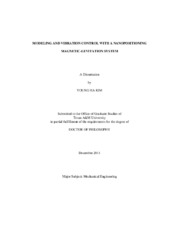| dc.description.abstract | This dissertation demonstrates that a magnetic-levitation (maglev) stage has the capabilities to control movements and reject vibration simultaneously. The mathematical model and vibration control scheme with a 6-degree-of-freedom (6-DOF) maglev stage for nanoscale positioning are developed for disturbance rejection. The derived full nonlinear dynamic equation of motions (EOMs) of the maglev stage include translational and rotational motions with differential kinematics. The derived EOMs and the magnetic forces are linearized to design a multivariable controller, a Linear Quadratic Gaussian with Loop Transfer Recovery (LQG/LTR), for vibration disturbance rejection in a multi-input multi-output (MIMO) system. For a more accurate model, the dynamics of an optical table with a pneumatic passive isolation system is also considered. The model of the maglev stage with the optical table is validated by experiments. Dual-loop controllers are designed to minimize the influence of the vibration disturbance between the moving platen and the optical table in the x-, y-, and z-axes motions. The inner-loop compensator regulates the velocity to reject vibration disturbance and the outer-loop compensator tracks positioning commands. When the vibration disturbances of 10 to 100 Hz are applied, the vibration-reduction ratios are about 30 to 65 percent in horizontal motion and 20 to 45 percent in vertical motion. In addition, the vibration disturbances of 45.45 Hz are attenuated by about 4 to 40 percent in angular motions. The vibration control schemes are effective in not only translational but rotational motions. In step responses, the vibration control schemes reduce the wandering range in the travel from the origin to another location. Positioning and tracking accuracies with the vibration controller are better than those without the vibration controller. In summary, these dual-loop control schemes with velocity feedback control improved the nanopositioning and vibration/disturbance rejection capabilities of a maglev system. | en |


